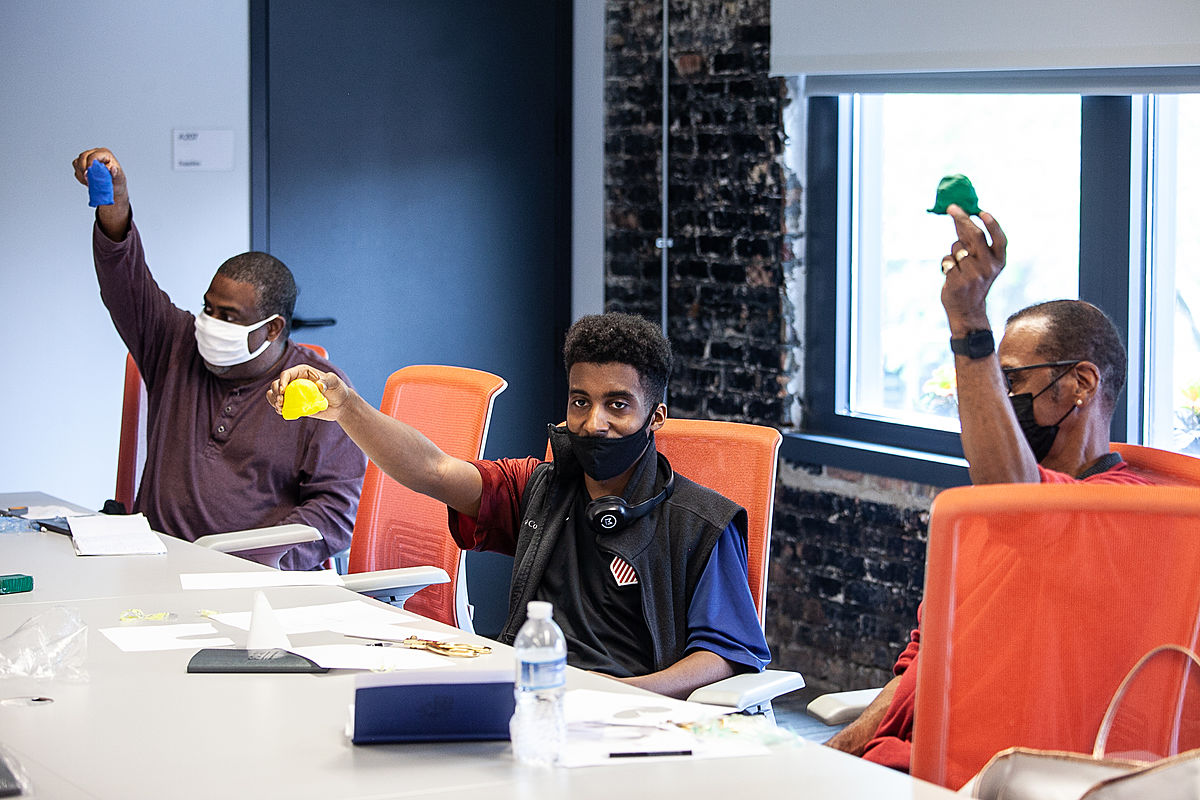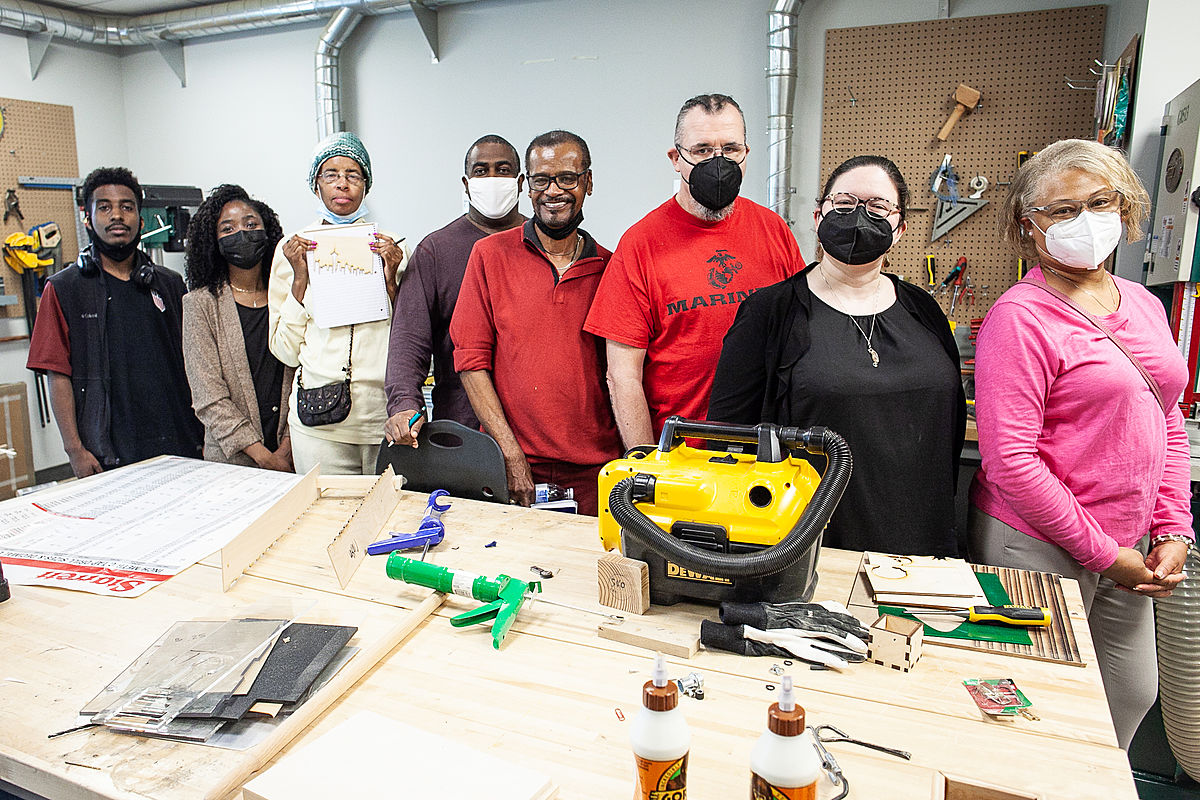When the pandemic shut down a Woodlawn industrial robotics training program, the partnership between the Bishop Arthur M. Brazier Foundation and the University enabled trainees to keep learning.
Freelance artist and graphic designer Kali Johnson is already an expert in many of the tools of his trade: digital illustration, motion graphics, 3D computer modeling, and more.
The South Shore resident is full of ideas to expand his business, like designing and producing skateboard components with recycled plastics. To learn a new set of tools that will help him explore the industrial design and manufacturing process, in late 2019 Johnson began a free training program in automation, programming, and robotics, offered by the Bishop Arthur M. Brazier Foundation in Woodlawn, a longtime University of Chicago partner.
When the COVID-19 pandemic shut down the training program in early 2020, the Brazier Foundation team met with colleagues at the Polsky Center for Entrepreneurship and Innovation to strategize ways to keep trainees learning.
"We talked about what would be most useful for their cohort," said Elizabeth Koprucki, assistant director of the Center’s Fab Lab––a suite of state-of-the-art equipment housed at the Polsky Exchange. The lab offers entrepreneurs from the University and the community the knowledge, support, and equipment they need to design and prototype new products.
After hearing that trainees had expressed interest in learning about other advanced manufacturing technologies, including 3D printing and prototyping, Koprucki contacted her peers in Chicago's community of makers to come up with a plan.
The result: In 2022, Johnson and four other Brazier Foundation trainees set out on a journey through four of Chicago's premier spaces for learning about 3D printing and advanced manufacturing. They visited the Wanger Family Fab Lab at the Museum of Science and Industry (MSI); MxD, a training and simulation center; the mHUB innovation center; and the Polsky Fab Lab.
"The overall objective of this introductory training program was to have the trainees explore and experience some of the resources that are available. Also, this training program allowed trainees to generate ideas about next steps in their careers or professional development," said Karen Williams, director of workforce development at the Brazier Foundation.
For Johnson, the chance to enter these spaces around the city felt like a rare and welcome opportunity. "Coming up as a Black man, we have this mindset that opportunities aren't meant for us. I decided I had to branch out and see what's going on."
At the MSI, trainees got the chance to try state-of-the-art 3D printing and design software. At MxD, they learned about high-tech tools for manufacturing settings, such as machine sensors that provide cybersecurity. The mHUB stop offered resources for freelance engineering and a conversation with entrepreneurs who use the space.

And at the Fab Lab, the tour's final stop in late May, Koprucki took the trainees back to the bedrock of design and prototyping: sketching ideas on paper and hand-building models from paper and modeling clay.
"You have to give people permission to start out by making a crappy thing," she said with a laugh. "Iteration is a really important part of the process. It's so much better to find out that people don't want your product when it's a cardboard model, before you spend $50,000 on custom molds for manufacturing."
The group got to see the importance of iteration up close, with a hands-on look at the multiple 3D models created at the Fab Lab for innovative products like the LuminAID solar-powered light.
Learning about the revision process was valuable for Johnson, who says he's working to tamp down his natural perfectionism and free himself to make less-than-perfect drafts and models. He was also impressed with the group's tour of Fab Lab technology, including a computer-controlled ShopBot digital fabrication tool, 3D printers, laser etchers, vinyl cutters, and more.

Welcoming the Brazier Foundation trainees to the Fab Lab is one example of the Polsky Center's work to provide resources for local entrepreneurs, part of a broader University commitment to supporting strong, vibrant South Side communities.
Community entrepreneurs who have no formal affiliation with the University are invited to join the Exchange as members. They have access to the Fab Lab plus all of the Exchange's educational and support offerings, including mentoring, community business workshops, a Small Business Growth Program, the South Side Pitch competition, and other resources.
While the Fab Lab's availability and programming are evolving in the wake of the pandemic, Koprucki remains committed to inviting local entrepreneurs into the space. "The Fab Lab is a unique resource, and we want to make sure it's available to the community," she said.
"It's essential for people to know that this is their space, too. And we know we can't just open the door: We have to invite people in" with programs like the tours of Chicago maker facilities.
Now that Johnson has experienced the Fab Lab in person, he plans to make it part of his creative and professional journey. Like his Greater Grand Crossing neighbor, artist and UChicago professor Theaster Gates, Johnson envisions eventually using proceeds from his art and design work to invest in properties where he can build economic and environmental resources for the community, such as an animation studio and plastics recycling plant.
"The Fab Lab is a place where I can learn as much as possible about all the opportunities before I commit to anything long term," he said. "I love it there: it's really close to where I live, it's affordable, and they have a lot of good resources."



